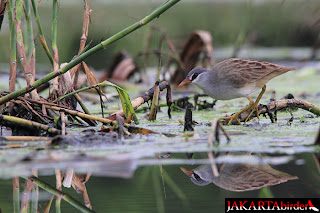Introduction: Baluran National Park is one of the best birding hot spot located at East Java. It takes around 8 hours drive from Surabaya. Highlight from this trip is the critically endangered Black-winged Starling (tricolor race), the endangered Green Peafowl, Green Junglefowl, Island Collared Dove, Spotted Kestrel, and Woolly-necked Stork.
It was a fruitful photography trip although I got no lifers and I missed the Java Sparrow. I'm so happy because finally I have a chance to take some pictures of Green Junglefowl, Green Peafowl, Black-winged Starling, and Island Collared Dove at a close range. I went there with some of my friends from Go Wild Indonesia. But, at the park I separate myself from the others and focusing on my target. That's why we're yielding different kind of birds, my friends saw some nice species, like Lesser Adjutant, Oriental Pied Hornbill, White-bellied Woodpecker, Red Junglefowl, Javan Plover, etc but I saw the main attraction of Baluran National Park the courtship display of male Green Peafowl in the wild. It is one of the stunning moment I've ever seen in my life.
When I show the pictures to my friends, they ask me how to get close to that Peafowl. I answer them, I just woke up early morning just like them, sat near the waterhole, and pray to GOD that your target will come to drink. Because I sat close enough to the waterhole, I cover myself with double-layered camouflage net so the animals will not be afraid and they can do their things naturally while I took their pictures.
For Black-winged Starling I do something that I've never been experienced before, climbing the tree with my camera hanging down on my shoulder. And one thing that I don't expected to see is the Black-winged Starling itself. Actually I climb the tree to take the Island Collared Dove, but they never perched on the open branch like the Black-winged Starling did.
 |
| A couple of Black-winged Starling perched on Acacia nilotica. |
 |
| A couple of Black-winged Starling perched on Acacia nilotica with Island Collared Dove group. |
 |
| Spotted Dove perched on Acacia nilotica. |
 |
| Island Collared Dove perched on Acacia nilotica. |
 |
| Male Green Peafowl Habitat. |
 |
| Male Green Peafowl with its long tail. |
 |
| Timor Deer is one of the easiest to see animal at Baluran National Park. |
 |
| Timor Deer is easy to be photographed if you sit lower than its height. |
 |
| Female Green Peafowl dust bathing. |
 |
| Female Green Peafowls during mid day roost. |
 |
| Female Green Peafowl during mid day roost. |
 |
| Female Green Peafowls foraging at Bekol Savanna. |
 |
| Female Green Peafowl has shorter tail than the male. |
 |
| Female Green Peafowl at the waterhole at Bekol Savanna. |
 |
| Male Green Peafowl at Savanna prefers to drink from the food trough than from the waterhole. Maybe because from there he has a wider view to watch its surrounding. |
 |
| Male Green Junglefowl at the waterhole near Bekol Guesthouse. |
 |
| Male Green Junglefowl at the waterhole near Bekol Guesthouse. |
 |
| Male Green Junglefowl at the waterhole near Bekol Guesthouse. |
 |
| Male Green Junglefowl at the waterhole near Bekol Guesthouse. |
 |
| Male and Female Green Junglefowl. |
 |
| Male Green Peafowl prefers to attract the female rather than have a drink from the waterhole. |
 |
| Island Collared Dove group at the waterhole near Bekol Guesthouse. |
 |
| Island Collared Dove group at the waterhole near Bekol Guesthouse. |
 |
| Male Green Junglefowl drinking at the same waterhole. |
 |
| When drinking, the Male Green Junglefowl still watching its surrounding. |
 |
| Male Green Peafowl fanning its tail to attract the females. |
 |
| Female Green Peafowl drinking from the waterhole while the male dancing not far from her position. |
 |
| Each Male Green Peafowl has different "eyes" number on its tail. |
 |
| Female Green Peafowl with dancing male in background. |
 |
| Female Green Peafowl at the waterhole near Bekol Guesthouse. |
 |
| Green Peafowl typical habitat at Baluran National Park. |
 |
| Record Shot of Spotted Kestrel. |
 |
| Record shot of Spotted Kestrel. |
 |
| Female Green Peafowl were looking for seeds. |




























































